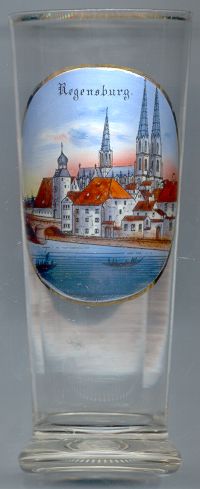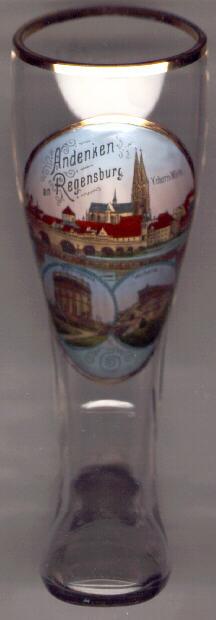

|
| DEUTSCHLAND | GERMANY |
| Bundesland: Freistaat Bayern | Bavaria |
| Regierungsbezirk: Oberpfalz | |
| Stadt: Regensburg |

 Regensburg (in English formerly Ratisbon) is situated at an elevation of 337 m on the Danube river.
It is the capital of the administrative region Oberpfalz (Upper Palatinate) and the district Regensburg.
the city has a population of about 150,200 (2004) and thus is the fourth-largest city in Bavaria.
Regensburg (in English formerly Ratisbon) is situated at an elevation of 337 m on the Danube river.
It is the capital of the administrative region Oberpfalz (Upper Palatinate) and the district Regensburg.
the city has a population of about 150,200 (2004) and thus is the fourth-largest city in Bavaria.
Regensburg is one of the oldest cities in Germany. Its documented history begins with the foundation of a Roman fort in 79 AD. The Celtic settlers who had inhabited the area already for some centuries had called the place Ratasbona or Ratisbona. In 179 AD the Romans founded the fort Castra Regina which became the main military base of the Raetia province. This fort existed for more than two centutries until, around 400 AD, it was abandoned during the times of the Migration of the Nations. Between about 500 and 788 it was the main seat of the Bavarian Agilolfinger dukes.
Regensburg also is one of the oldest dioceses in Germany. In 739 St. Boniface founded the diocese according to Canonic Law. Although the city became Protestant in 1542 it always remained a Catholic bishop's seat, although the bishopric at times was administered by other dioceses. Regensburg also was the location of one of the earliest Jewish communities in Bavaria, one of the most important in Europe during the Middle Ages. Its first mention dates back to 981 AD.
During the 9th century, Regensburg was one of the most important centres of the Carolinigian East Frankish Kingdom. Hemma (d.876), the consort of King Ludwig II ('the German'), as well as Arnulf of Carinthia (German King 887, Emperor 896, d.899) and his son Ludwig IV ('the Child') (German King 900, d.911), were buried here in the Benedictine monastery of St. Emmeram.
Between 1207 and 1256 Regensburg enjoyed the status of a Fere Imperial City. The economical independence of the town was also furthered by the profitable long-distance trade and the fact that the Bavarian dukes in 1255 moved their residence to Landshut and later to Munich. The attempts to get more independence finally got Regensburg in opposition to the Wittelsbacher dukes of Bavaria. In 1486 the town had to surrender to Upper Bavaria but had to be returned to the Emperor in 1496.
Since 1549 the diets of the Holy Roman Empire had only taken place in Regensburg. In 1663 the diet was not dissolved any more and thus became the 'Eternal Diet' which lasted until the dissolution of the Empire in 1806. About 70 embassies had their seat in Regensburg, the emperor was represented by 'Principal Commissionaries'. Since 1748 this function was a prerogative of the Princes of Thurn and Taxis. The last session of the diet took place in 1803 and ended with the publication of the 'Reichsdeputationshauptschluss' which reorganised the Empire after the loss to France of the countries left of the Rhine after the Peace of Lunéville of 1802 by reallocating the secularised ecclesiastical states and most of the former former free imperial cities to those princes that had lost their countries. Regensburg was made a new principality ruled by the former archbishop of Mainz. The territory consisted of the principality of Aschaffenburg (formerly the Electorate of Mainz), the bishopric and city of Regensburg itself, and the County of Wetzlar (formerly a Free Imperial City). In 1810, however, Napoleon dissolved the principality and handed it to the Kingdom of Bavaria, while Dalberg was given the new Grand Duchy of Frankfurt.
During the 19th century Regensburg gained importance again especially after the opening in 1859 of the railrods to Nuremberg and Munich. Although the town was severely hit by Allied bomb raids in 1945, the damages mostly hit the outer town districts around the Messerschmitt aircraft manufacture. The historic town of Regensburg today is the largest medieval town centre in Germany. The historic old town of Regensburg with Stadtamhof was listed as a World Cultural heritage site by UNESCO in 2006 (see also list of World Heritage sites depicted on other glasses of this collection).
The  cathedral Sankt Peter stands on a site that was occupied by an earlier church
which had been destroyed around 1150. The present church was begun a century later, around 1250. It is one of the
most important Gothic cathedrals in Germany. The 'Eselsturm' ('Donkey's Tower') on the north side of the church is
a remainder of the previous, Romanesque church. The interior of the church was redecorated in Baroque style in 1697.
The building works, however, continued until 1856 and were completed with the construction of the Neogothic tower roofs.
During this last construction period the Baroque domed roof and the Baroque frescos were removed.
cathedral Sankt Peter stands on a site that was occupied by an earlier church
which had been destroyed around 1150. The present church was begun a century later, around 1250. It is one of the
most important Gothic cathedrals in Germany. The 'Eselsturm' ('Donkey's Tower') on the north side of the church is
a remainder of the previous, Romanesque church. The interior of the church was redecorated in Baroque style in 1697.
The building works, however, continued until 1856 and were completed with the construction of the Neogothic tower roofs.
During this last construction period the Baroque domed roof and the Baroque frescos were removed.
The second-most loved landmark of Regensburg is the
 Steinerne
Steinerne Salzstadel
Salzstadel Brückturm
Brückturm
The two small additional pictures on glass no. 090 [top right] show the
 Befreiungshalle
Befreiungshalle Walhalla
Walhalla
![[scale]](lineal.jpg)